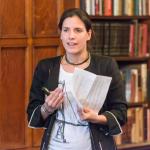From physicists to engineers to meds to plumbers: thoughts on Esther Duflo’s ASSA 2017 lecture on rediscovering the last art of economics
The gist of Esther Duflo’s American Economic Association
But it quickly appeared Duflo wasn’t merely aiming at repackaging. She was calling for a more radical “mindset change.” She wanted economists to reconceive economic agents, policy-makers and bureaucrats as bounded “humans” embedded in wider power structures and cultures, and to realize that thinking goods ideas is not enough to improve the latter’s welfare. “Incentive architecture” is thus needed, and economics expertise is especially relevant because it deals with behavioral, incentive and market equilibrium issues. The recent success of (some) “nudge” has given some salience to benefits of crafting incentives carefully, for instance by fixing regulations to prevent firms from exploiting loopholes. Plumbing was also beneficial for economics as science, she continued, as it helped generate counterfactuals by randomizing on entire markets. Plumbing also shines the spotlight on issues theorists had previously ignored, like how important the default scenario is. Economics as plumbing requires a more pragmatic and experimental mindset, she concluded, as it requires them to make decision without having a full knowledge of the system to be tinkered (“tinkering” was one of the keywords of the speech).
Scientists, engineers, meds: the shifting identity of economists
Though Duflo was very cautious in her talk, making her plumbering analogy a call for humility, her claims are more transformative that they sound. Ely lectures are, like presidential addresses, a primary vehicle to address the state of the discipline, to reflect about economists’ proper objects of study, methods and social role. Jacob Viner had started the series by reflecting on “The Economist in History” in 1962. These lectures are, in fact, often attempts to shape and reshape economists’ identity.. My take is that Duflo’s talk is no exception, and that putting her attempt to alter economists’ identity by comparing them to other professionals into (sketchy) historical perspective might highlight her goals.
These comparisons are tricky material for historians, because they have often been more than just metaphors. What economists have borrowed from other sciences, disciplines and practices include image but also questions, objects of study, tools, epistemological and social relevance criteria. In the XIXth century, political economy was considered as a positive science, but also as a branch of ethics and as an art.“It is a further questions whether or not we should also recognize, as included under political economy in the widest sense – but distinct from the positive science – (a) a branch of ethics which may be called the ethics of political economy, and which seels to determine economics ideals; and (b) an art of political economy, which seeks to formulate economic precepts, John Neville Keynes wrote
The last 100 years can indeed been construed as an irresistible march toward making economics a science, notably by emulating physics. Philip Mirowksi showed that this physics envy included borrowing methodological claims (Popperian deductive approach, economics being concerned with identifying laws), metaphors (“energy”, “body”, “movement”, values”) and mathematical models and tools (law of energy conversion them thermodynamics). The physics comparison was a rhetorical weapon, wielded by NBER’s Wesley Mitchell in the 1940s during the discussing following Vannevar Bush’s Science: The Endless Frontier report (Bush and his fellow physicists advocated federal funding for “sciences.” Alas, the resulting National Science Foundation, established in 1950, did not cover any social science). But the pervasive reference to physics also reflected genuine emulation, as seen in Roger Backhouse forthcoming biography of Paul Samuelson. In the late 1930s, the young Chicago sophomore decided to start a diary in the 1930 to reflect on Frank Knight, Jacob Viner and his other teachers’ ideas, Backhouse relates. Its first sentence set the tone of Samuelson’s (hence the whole profession’s) methodological vision:
“Science is essentially the establishing of Cause and Effect relationships. This knowledge can be utilized in controlling causes to produce desired effects. It is the realm of philosophy to decide what these objectives shall be, and that of science to achieve those decided upon.”
After World War two, Mirowski argued in a follow-up volume, economists gradually shifted to information science metaphor (“machine dream”). It was however another comparison that gained currency in that period: the economist as engineer. Of course, several economists have been trained as engineers for more than a century. Those French economists-engineers trained at Polytechnique and the Grand Corps d’Etat have, from Jules Dupuit to Marcel Boiteux, applied their tools to rationalize public management and set prices for public goods and utilities. Tool exchanges between operational research and economics have been numerous in the postwar, especially in those universities with strong engineering tradition (MIT, Carnegie). Many of those economists who developed lab experiment and mechanism design, like Vernon Smith or Steve Rassenti, were trained as engineers. One of them, Al Roth, graduated from Stanford’s Operational Research program before applying his game theoretic tools to economic issues. Yet, he said, he felt that was really doing the same science, and he later wrote the famous paper that stabilized market designers’ economic identity as engineers and scientists: “if we want market design to be better informed and more reliable in the future, we need to promote a scientific literature of design economics. Today this literature is in its infancy. My guess is that if we nurture it to maturity, its relations with current economics wll be something like the relationship of engineering and physics, or of medicine and biology,” he wrote.
The engineering metaphor was taken up by many other economists, including Bob Shiller, in his defense of his shared Nobel Prize: “economic phenomena do not have the same intrinsic fascination for us as the internal resonance of the atom […]. We judge economics by what it can produce. As such, economics is rather more like engineering than physics, more practical than spiritual,” he explained, before claiming that engineering should have its Nobel too. That Shiller and Fama held opposed views of how financial markets work came under such fire that Raj Chetty also weighted in. Yes, economics is a science, he hammered, but one akin to medicine. “The kind of empirical work in economics might be compared to the “micro” advances in medicine (like research on therapies for heart disease) that have contributed enormously to increasing longevity and quality of life, even as the “macro” questions of the determinants of health remain contested,” he explained.
These engineering and medicine comparisons served various purposes. In the wake of the financial crisis, Shiller and Chetty used them to argue that a discipline can yield scientific and useful knowledge in spite of its approximations, limits, and possible mistakes. But considering medicine as a repository of scientific methods to tap was also on Alan Krueger and Esther Duflo’s agenda. Krueger interestingly relates how he used to read the New England journal of Medicine. In her Ted talk laying out her randomized experiments methodology, Duflo was more straightforward: “these economics I’m proposing, it’s like 20th century medicine. It’s a slow, deliberative process of discovery. There is no miracle cure, but modern medicine is saving millions of lives every year, and we can do the same thing.” And in a recent book, French economists Pierre Cahuc and André Zylberberg created a stir by calling all those economics works that did not rely on the kind of careful causal identification medicine proposed “negationism.”
Rediscovering the “art” of economics?
In her Ely lecture, Duflo is thus moving away from medicine envy. To what extent her “economists-as-plumber” comparison is merely metaphorical is unclear, but she carried it throughout her talk, one riven with pipes, taps, leaks, flowcharts, and verbs like fixing and tinkering. But the key question is not as much about the nature of the comparison as it is about its purpose. How much does she wants economists’ identity shifted? At the beginning of her talk, she offered a reassuring sense of continuity. Scientists provide the general framework that guides the design of policies and markets, she clarified. Roth’s engineer takes this framework and confronts it to real situation, but “he knows what the are important features of the environment and tries to design the machine to address them.” “The plumber goes one step further,” she continued: “she fits the machine in the real world, carefully watches out what happens and tinkers as needed.”
But the plumbing epistemology cannot be one whereby a preexisting scientific framework is applied, her later arguments reveal. Though she is not explicit about breaking from the rationality assumption, plumbers consider economic agents as neither endowed with perfect information, foresight and computing abilities nor fully rational in their decisions. Though her talk leaves the science of economics intact because distinct from plumbering, the latter in fact has the ability to transform what the theorist focuses on and what phenomena he needs to explain. What she might implicitly suggest is that economists should be less deductive and more inductive. The economist-as-plumber cannot wait for scientific knowledge to be mature and complete, she eventually warned. There’s a good deal of guesses, trial-and-errors and tinkering that economists should be willing to accept. In arguing this, Duflo is exactly in line with Paul Romer’s recent statement that economists should emulate those surgeons who cannot afford to wait for clean causal identification to make life-and-death decision. “Delay is costly. Impatience is a virtue,” he concluded. The plumber comparison also echoes Greg Mankiw’s distinction between macroeconomists-as-scientist and macroeconomist-as-engineer. Duflo’s Ely lecture might be a sign, then, that economists have recently rediscovered the lost art of economics.
This piece first appeared on Beatrice Cherrier’s personal blog.







